Of the roughly 13,500 identified species of macroscopic, mushroom-forming fungi, about 8,500 are gilled. These mushrooms exist within multiple orders of Agaricomycetes. Gilled mushrooms produce thin, slit-like spore-dispersing tissues underneath the cap. These tissues hang vertically and are typically arranged radially from the center of the cap to the margin. In mycological terms, these gills are known as lamellae. The vertically arranged structure of gills allows for a 20-fold increase in surface area for spore production compared to a flat surface. Since this adaptation is so successful, this spore-dispersal plan is found in thousands of mushroom species.
In this guide, we’ll provide a glimpse into the immense diversity of gilled mushrooms by discussing six families of gill-producing mushrooms found in the class Agaricomycete.
Read on to learn more!
1. Types of Gilled Mushrooms: Agaricaceae
The fungal family Agaricaceae contains about 1,300 species across 85 genera, with the majority producing gills. One of the most commonly commercially cultivated mushrooms belongs to this family- Agaricus bisporus (AKA the button mushroom, cremini, and portobello). Most species in Agaricaceae are saprobic, meaning the fungi derive their nutrients from decaying organic matter. This matter primarily includes logs, stumps, branches, twigs, leaf litter, manure, and grass thatch.
Wild mushrooms in this family typically occur in temperate regions of the Northern Hemisphere. They can occur in forests, meadows, gardens, and along trails and roadsides. Three examples of gilled mushrooms in the Agaricaceae family include:
- Field mushroom (Agaricus campestris). As a species complex, it is distributed throughout grassy temperate regions of Europe, Asia, North America, Australia, and New Zealand.
- Stinking dapperling (Lepiota cristata). Distributed widely in grassy and forested areas throughout North America (except Mexico), Europe, northern Asia, and New Zealand.
- Shaggy mane (Coprinus comatus). Distributed in grassy areas across temperate regions of mainland Europe, North Africa, North America, Asia, and Australia.
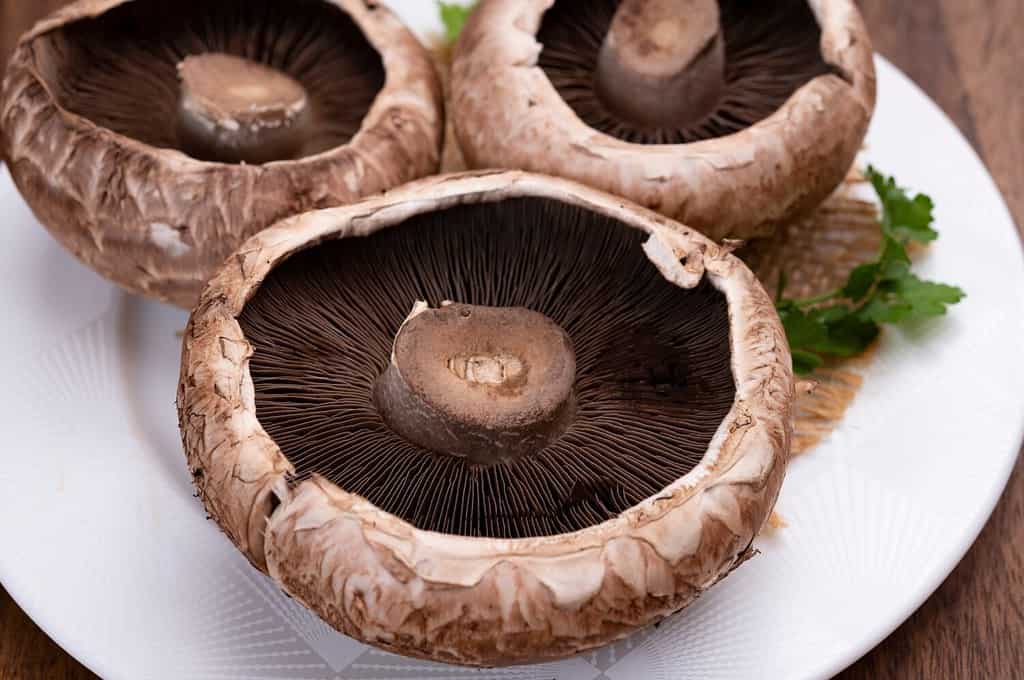
The portobello, along with button mushrooms, are probably the most recognized mushrooms in the supermarket.
©barmalini/Shutterstock.com
2. Amanitaceae
Mycologists have identified over 600 species of gilled mushrooms in the Amanitaceae family. Some current estimates approximate well over 1,000 species occurring worldwide. This family of mushrooms also contains some of the most deadly-to-humans species due to the presence of amatoxins in some species. Most of the species in this family exist within the genus Amanita, although currently, four other smaller genera belong to Amanitaceae. Currently, accepted genera in this family include Amanita, Catatrama, Limacella, Limacellopsis, and Myxoderma. Interestingly enough, while the majority of species in this family are gilled, a small number of subterranean truffle-like species occur in Australia.
The majority of species in this family are mycorrhizal, meaning they derive their nutrients from a mutually beneficial plant-fungi relationship. The plant roots provide sugar and carbon to the underground portion of the fungus (mycelium). In turn, the mycelium scavenges the soil for essential plant nutrients, such as phosphorus and nitrogen, to provide the roots.
While there is a debate surrounding this, some mycologists consider Amanita to be the largest genus of mushrooms. Many of the species feature white, olive-white, creamy-white, and/or greyish fruiting bodies, while some other species display stunning orange, yellow, and red coloration. Examples of gilled mushrooms in the Amanitaceae family include:
- Eastern North American destroying angel (Amanita bisporigera). Deadly to humans, this all-white poisonous Amanita occurs in oak-dominated hardwood forests throughout eastern North America.
- Fly agaric (Amanita muscaria). A stunningly beautiful, white-spotted red or orange-capped, psychoactive mushroom distributed across temperate and forested regions of the Northern Hemisphere.
- Caesar’s mushroom (Amanita caesarea). A highly-regarded edible amanita mushroom native to southern Europe and North Africa featuring yellow, orange, and white coloration.
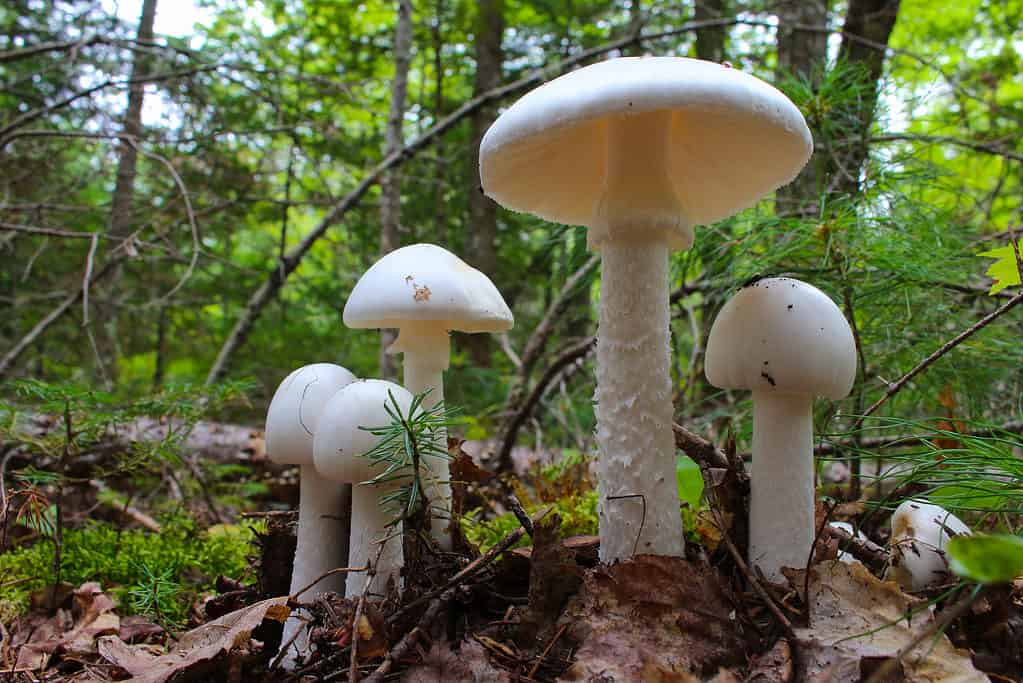
Amatoxins-containing amanitas are responsible for over 90% of all fatal mushroom poisonings of humans in the world.
©gvictoria/Shutterstock.com
3. Types of Gilled Mushrooms: Cortinariaceae
The Cortinariaceae family of mostly gilled mushrooms contains an estimated 3,000 species. Evidently, some mycologists currently propose categorizing them into seven to ten genera! This family is highly diverse and occurs throughout temperate, tropical, and even arctic-alpine environments. Some researchers suspect Cortinariaceae to be the largest and most variable family of gilled mushrooms. Most species in this family are mycorrhizal.
A distinguishing characteristic of mushrooms within the large Cortinarius genus is the presence of a cobweb-like partial veil called the cortina. The partial veil is a thin, membranous tissue covering and protecting young specimens’ gills.
Three examples of gilled mushrooms in the diverse Cortinariaceae family include:
- Violet webcap (Cortinarius violaceus). Featuring a vividly violet fruiting body when fresh, Cortinarius violaceus is a delight to come across throughout temperate hardwood or conifer forests across its native range of the Northern Hemisphere.
- Saffron webcap mushroom (Cortinarius croceus). This saffron-capped and yellow-gilled mushroom occurs in temperate to alpine-arctic forested regions throughout North America and Europe.
- Australian white webcap (Cortinarius austroalbidus). Forming a mycorrhizal relationship with eucalyptus trees, the Australian white webcap occurs throughout eucalyptus forests of temperate southern Australia.
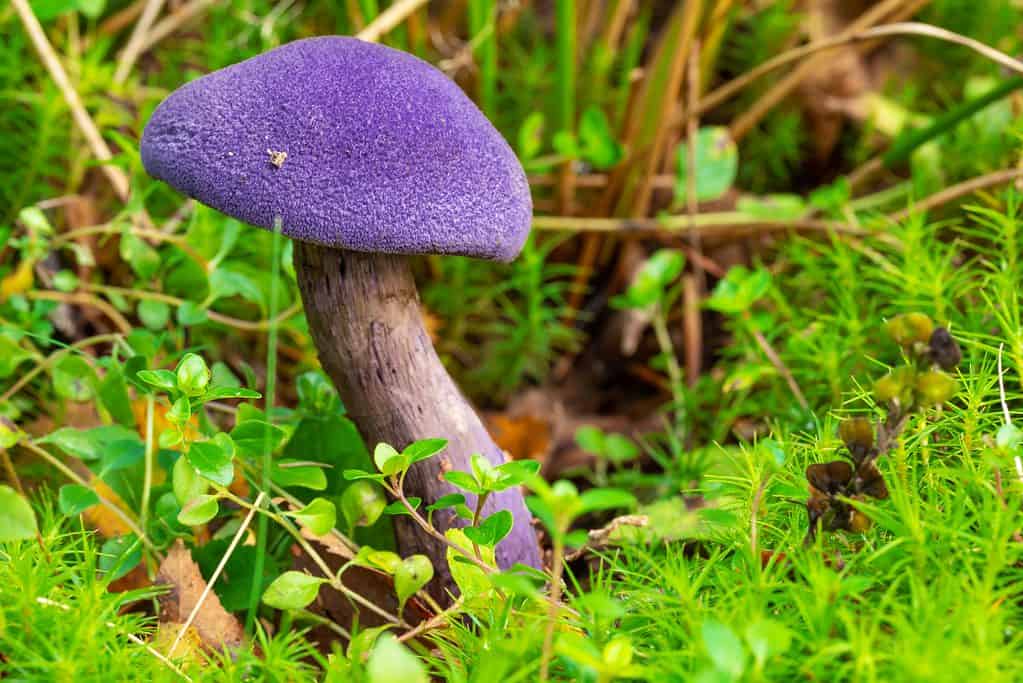
is one of the most well-known and prettiest mushrooms in the genus.
©Phant/Shutterstock.com
4. Entolomataceae
The majority of mushroom species in the family Entolomataceae are gill-producing, although a small minority are cyphelloid (producing tiny cup, disc, or tube-shaped fruiting bodies). At least 1,500 species occur in this family, categorized into a currently debated number of genera. The largest genus within this family is Entoloma, which contains primarily gilled mushrooms that produce a salmon-pink spore print. Like the Cortinaceae family, Entolomataceae occurs worldwide from tropical to arctic environments. Most species are saprotrophic.
Three examples of gilled mushrooms in this fungal family include:
- Springtime entoloma (Entoloma vernum)- As its common name suggests, Entoloma vernum fruits in conifer forests in the spring throughout temperate regions of Europe and possibly North America.
- Entoloma eugenei– A rare, endangered species occurring across temperate hardwood forests of the Russian Far East and East Asia, Entoloma eugenei features an uncommonly strikingly blue stipe (aka stem) and cap.
- Entoloma sequestratum– Described as a species new to science in 2020, Entoloma sequestratum inhabits wet, tropical habitats of northern Thailand.
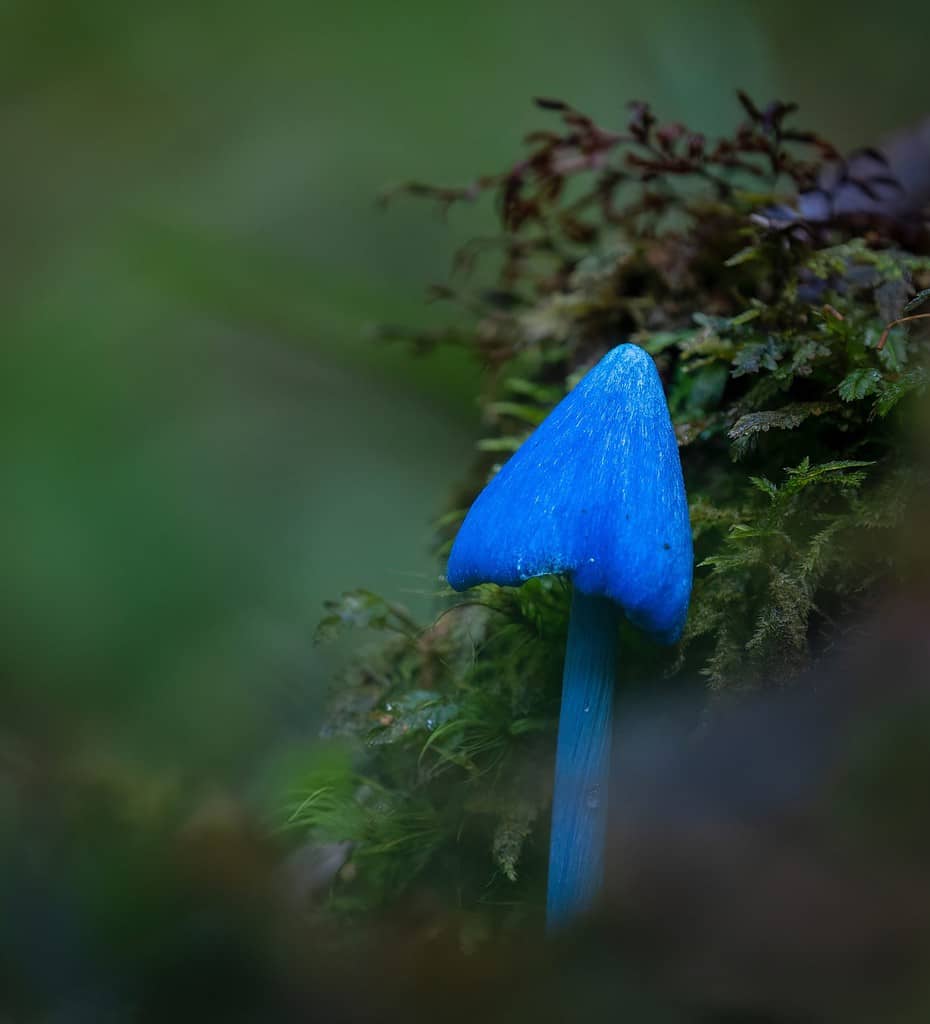
is a gorgeous blue mushroom.
©Janice Chen/Shutterstock.com
5. Types of Gilled Mushrooms: Russalaceae
The Russulaceae family contains about 1,900 gilled mushroom species, mostly within the largest genus, Russula (brittlegills). The second largest genus is Lactarius (milk-caps), which contains gilled mushrooms that secrete a milky latex substance from the gills. The species in Russula are often quite difficult to identify down to a species level in the field, and some are even tricky to distinguish under a microscope. Russulaceae has a worldwide distribution, with species occurring in temperate and tropical regions of the Americas, Asia, Africa, Australasia, and Europe. Most species in this family are mycorrhizal, often with orchids, while some are saprobic or parasitic.
Three examples of gilled species in Russulaceae include:
- The sickener (Russula emetica)- It’s common and scientific name suggest that it’s toxic, but some cultures historically and presently eat this mushroom. Proper cooking or pickling is crucial to making the mushroom palatable. This species does occur across temperate, forested regions of North Africa, Asia, and Europe. It’s existence in North America is currently debated.
- Blue-Green Cracking Russula (Russula parvovirescens)- Russula parvovirescens is a delightful edible mushroom that primarily occurs across hardwood forests east of the Rocky Mountains.
- Indigo milk cap (Lactarius indigo)- A highly prized and truly stunning edible mushroom, Lactarius indigo features strikingly indigo-blue gills, cap, and stipe. It also bleeds blue latex! It primarily occurs across eastern North America, East Asia, and Central America.

has a unique “quilted” look to its cap.
©Svarun/Shutterstock.com
6. Types of Gilled Mushrooms: Mycenaceae
Represented by about 700 species across 10 genera, the Mycenaceae family feature small, whimsical gilled mushrooms. This family of mushrooms is the most bioluminescent of the macro fungi with most glowing species occurring in the Mycena genus. This family is saprobic and primarily grows on rotting logs. Mycenaceae has a worldwide distribution in temperate, tropical, and alpine-arctic.
Three examples of gilled mushrooms in Mycenaceae include:
- Mycena pasvikensis– This unassuming but resilient little brown mushroom occurs almost exclusively in alpine-arctic regions of northern Europe.
- Green Pepe (Mycena chlorophos)- One of the most notably bioluminescent species in the genus, Mycena chlorophos is strikingly translucent-white in the day but emits a green glow at night. This species occurs in subtropical regions of Asia, South America, Polynesia, and Australia.
- Orange mycena (Mycena leaiana)- Occurring widely from the Great Plains eastward, Mycena leaiana is a strikingly orange species that typically grows in abundant clusters and features gills that are wavy towards the margin.
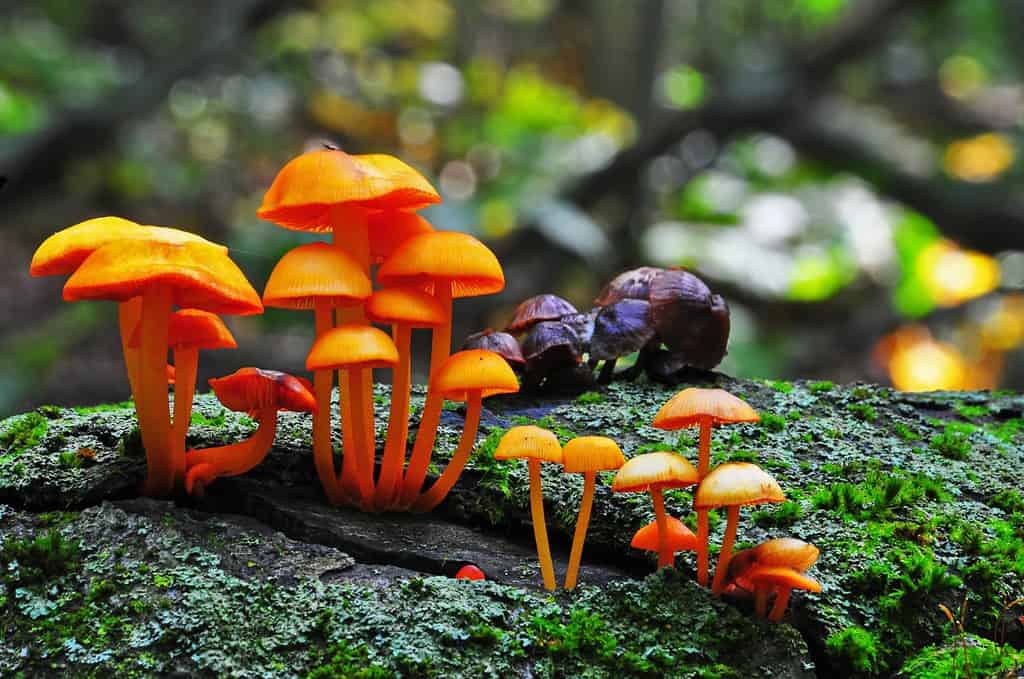
The orange mycena aka
Mycena leaianais an eye-catchingly whimsical mushroom.
©Doug Gordon/Shutterstock.com
The photo featured at the top of this post is © iStock.com/aletheia97
The information presented on or through the Website is made available solely for general informational purposes. We do not warrant the accuracy, completeness, or usefulness of this information. Any reliance you place on such information is strictly at your own risk. We disclaim all liability and responsibility arising from any reliance placed on such materials by you or any other visitor to the Website, or by anyone who may be informed of any of its contents. None of the statements or claims on the Website should be taken as medical advice, health advice, or as confirmation that a plant, fungus, or other item is safe for consumption or will provide any health benefits. Anyone considering the health benefits of particular plant, fungus, or other item should first consult with a doctor or other medical professional. The statements made within this Website have not been evaluated by the Food and Drug Administration. These statements are not intended to diagnose, treat, cure or prevent any disease.
Thank you for reading! Have some feedback for us? Contact the AZ Animals editorial team.







